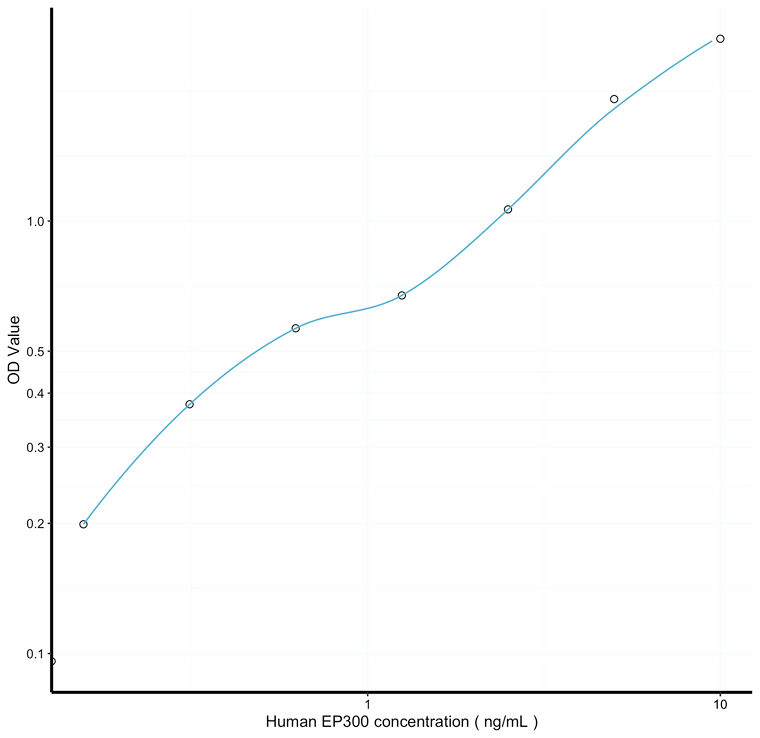| Post Translational Modifications | Acetylated on Lys at up to 17 positions by intermolecular autocatalysis. Deacetylated in the transcriptional repression domain (CRD1) by SIRT1, preferentially at Lys-1020. Deacetylated by SIRT2, preferentially at Lys-418, Lys-423, Lys-1542, Lys-1546, Lys-1549, Lys-1699, Lys-1704 and Lys-1707. Citrullinated at Arg-2142 by PADI4, which impairs methylation by CARM1 and promotes interaction with NCOA2/GRIP1. Methylated at Arg-580 and Arg-604 in the KIX domain by CARM1, which blocks association with CREB, inhibits CREB signaling and activates apoptotic response. Also methylated at Arg-2142 by CARM1, which impairs interaction with NCOA2/GRIP1. Sumoylated.sumoylation in the transcriptional repression domain (CRD1) mediates transcriptional repression. Desumoylated by SENP3 through the removal of SUMO2 and SUMO3. Probable target of ubiquitination by FBXO3, leading to rapid proteasome-dependent degradation. Phosphorylated by HIPK2 in a RUNX1-dependent manner. This phosphorylation that activates EP300 happens when RUNX1 is associated with DNA and CBFB. Phosphorylated by ROCK2 and this enhances its activity. Phosphorylation at Ser-89 by AMPK reduces interaction with nuclear receptors, such as PPARG. |
| Function | Functions as histone acetyltransferase and regulates transcription via chromatin remodeling. Acetylates all four core histones in nucleosomes. Histone acetylation gives an epigenetic tag for transcriptional activation. Mediates cAMP-gene regulation by binding specifically to phosphorylated CREB protein. Mediates acetylation of histone H3 at 'Lys-122' (H3K122ac), a modification that localizes at the surface of the histone octamer and stimulates transcription, possibly by promoting nucleosome instability. Mediates acetylation of histone H3 at 'Lys-27' (H3K27ac). Also functions as acetyltransferase for non-histone targets, such as ALX1, HDAC1, PRMT1 or SIRT2. Acetylates 'Lys-131' of ALX1 and acts as its coactivator. Acetylates SIRT2 and is proposed to indirectly increase the transcriptional activity of p53/TP53 through acetylation and subsequent attenuation of SIRT2 deacetylase function. Following DNA damage, forms a stress-responsive p53/TP53 coactivator complex with JMY which mediates p53/TP53 acetylation, thereby increasing p53/TP53-dependent transcription and apoptosis. Promotes chromatin acetylation in heat shock responsive HSP genes during the heat shock response (HSR), thereby stimulating HSR transcription. Acetylates HDAC1 leading to its inactivation and modulation of transcription. Acetylates 'Lys-247' of EGR2. Acts as a TFAP2A-mediated transcriptional coactivator in presence of CITED2. Plays a role as a coactivator of NEUROD1-dependent transcription of the secretin and p21 genes and controls terminal differentiation of cells in the intestinal epithelium. Promotes cardiac myocyte enlargement. Can also mediate transcriptional repression. Acetylates FOXO1 and enhances its transcriptional activity. Acetylates BCL6 wich disrupts its ability to recruit histone deacetylases and hinders its transcriptional repressor activity. Participates in CLOCK or NPAS2-regulated rhythmic gene transcription.exhibits a circadian association with CLOCK or NPAS2, correlating with increase in PER1/2 mRNA and histone H3 acetylation on the PER1/2 promoter. Acetylates MTA1 at 'Lys-626' which is essential for its transcriptional coactivator activity. Acetylates XBP1 isoform 2.acetylation increases protein stability of XBP1 isoform 2 and enhances its transcriptional activity. Acetylates PCNA.acetylation promotes removal of chromatin-bound PCNA and its degradation during nucleotide excision repair (NER). Acetylates MEF2D. Acetylates and stabilizes ZBTB7B protein by antagonizing ubiquitin conjugation and degradation, this mechanism may be involved in CD4/CD8 lineage differentiation. Acetylates GABPB1, impairing GABPB1 heterotetramerization and activity. Acetylates PCK1 and promotes PCK1 anaplerotic activity. Acetylates RXRA and RXRG. Acetylates isoform M2 of PKM (PKM2), promoting its homodimerization and conversion into a protein kinase. Acetylates RPTOR in response to leucine, leading to activation of the mTORC1 complex. In addition to protein acetyltransferase, can use different acyl-CoA substrates, such as (2E)-butenoyl-CoA (crotonyl-CoA), butanoyl-CoA (butyryl-CoA), 2-hydroxyisobutanoyl-CoA (2-hydroxyisobutyryl-CoA), lactoyl-CoA or propanoyl-CoA (propionyl-CoA), and is able to mediate protein crotonylation, butyrylation, 2-hydroxyisobutyrylation, lactylation or propionylation, respectively. Acts as a histone crotonyltransferase.crotonylation marks active promoters and enhancers and confers resistance to transcriptional repressors. Histone crotonyltransferase activity is dependent on the concentration of (2E)-butenoyl-CoA (crotonyl-CoA) substrate and such activity is weak when (2E)-butenoyl-CoA (crotonyl-CoA) concentration is low. Also acts as a histone butyryltransferase.butyrylation marks active promoters. Catalyzes histone lactylation in macrophages by using lactoyl-CoA directly derived from endogenous or exogenous lactate, leading to stimulates gene transcription. Acts as a protein-lysine 2-hydroxyisobutyryltransferase.regulates glycolysis by mediating 2-hydroxyisobutyrylation of glycolytic enzymes. Functions as a transcriptional coactivator for SMAD4 in the TGF-beta signaling pathway. (Microbial infection) In case of HIV-1 infection, it is recruited by the viral protein Tat. Regulates Tat's transactivating activity and may help inducing chromatin remodeling of proviral genes. Binds to and may be involved in the transforming capacity of the adenovirus E1A protein. |







